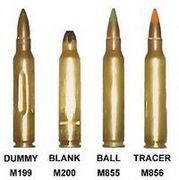- 詳細 2019年2月25日 03:40更新
-
5.56 × 45 mm NATO, designated STANAG 4172, is the standard rifle cartridge for NATO forces. It is derived from, but not entirely interchangeable with, the .223 Remington cartridge.
History
-----------------------------------------------
The previous standard NATO round was the 7.62 × 51 mm, derived from the .300 Savage rifle cartridge and designed to replace the U.S. military's .30-06 Springfield rifle cartridge. At the time of selection, there had been criticism that the 7.62 mm round was too powerful for modern assault rifles, causing excessive recoil, and that the weight of the ammunition did not allow for enough "firepower" in modern combat.
The British had extensive evidence with their own experiments into an "intermediate" round and were on the point of introducing a .280 inch (7 mm) round. The FN company had also been involved. These concerns were effectively overruled by the US within NATO, and the other NATO nations accepted that standardization was more important at the time than selection of the ideal round. These concerns would prove to be valid and led to the development of the 5.56 cartridge.
During the late 1950s, ArmaLite and other U.S. firearm designers started their individual Small Caliber/High Velocity (SCHV) assault rifle experiments using the commercial .222 Remington cartridge. When it became clear that there was not enough powder capacity to meet U.S. Continental Army Command's (CONARC) velocity and penetration requirements, ArmaLite contacted Remington to create a similar cartridge with a longer case body and shorter neck. This became the .222 Remington Special. At the same time, Springfield Armory's Earle Harvey had Remington create an even longer cartridge case then known as the .224 Springfield. Springfield was forced to drop out of the CONARC competition, and thus the .224 Springfield was later released as a commercial sporting cartridge known as the .222 Remington Magnum. To prevent confusion with all of the competing .222 cartridge designations, the .222 Remington Special was renamed the .223 Remington. After playing with their own proprietary cartridge case design, the .224E1 Winchester, Winchester eventually standardized their case dimensions, but not overall loaded length, with the .222 Remington Special to create a cartridge known as the .224E2 Winchester. With the U.S. military adoption of the ArmaLite AR-15 as the M16 rifle in 1963, the .223 Remington was standardized as the 5.56 × 45 mm. However, the .223 Remington was not introduced as a commercial sporting cartridge until 1964.
During the 1970s, NATO members signed an agreement to select a second, smaller caliber cartridge to replace the 7.62 mm NATO. Of the cartridges tendered, the 5.56 mm was successful, but not the 5.56 mm loading (M193 Ball) as used by the U.S. at that time. Instead, the Belgian FN SS109 loading was chosen for standardization. The SS109 used a heavier bullet at a lower muzzle velocity for better long-range performance, specifically to meet a requirement that the bullet be able to penetrate through one side of a steel helmet at 600m. Some believe that this requirement has made the M855 less capable of fragmentation than the M193 as discussed below.
Performance
-----------------------------------------------
The 5.56 × 45 mm NATO cartridge with the standard military ball bullet (NATO: SS109; U.S.: M855) will penetrate approximately 15 to 20 inches (380 to 500 mm) into soft tissue in ideal circumstances. As with all spitzer shaped projectiles it is prone to yaw in soft tissue. However, at impact velocities above roughly 2,700 ft/s (820 m/s), it will yaw and then fragment at the cannelure (the groove around the cylinder of the bullet). The fragments disperse through the flesh causing much more internal injury. The effectiveness of fragmentation seems to impart much greater damage to tissue than bullet dimensions and velocities would suggest. This fragmentation effect is highly dependent on velocity, and therefore barrel length: short-barreled rifles generate less muzzle velocity and therefore rounds lose effectiveness at much shorter ranges than longer-barreled rifles.
There has been much criticism of the poor performance of the round, especially the first-round kill rate when using firearms that don't achieve the velocity to cause fragmentation. Typically, this only becomes an issue at longer ranges (over 100 meters) but this problem is compounded in shorter-barreled weapons. The 14.5-inch barrel of the U.S. military's M4 Carbine can be particularly prone to this problem. At short ranges, the round is extremely effective, and its tendency to fragment reduces the risk to bystanders when used at close range. However, if the round is moving too slowly to reliably fragment on impact, the wound size and potential to incapacitate a target is greatly reduced.
Recently, advances have been made in 5.56 mm ammunition. The US military has adopted for limited issue a 77-grain "Match" bullet, type classified as the Mk 262. The heavy, lightly constructed bullet fragments more violently at short range and also has a longer fragmentation range. Originally designed for use in the Mk 12 SPR, the ammunition has found favor with special forces units who were seeking a more effective round to fire from their M4A1 carbines.
Another specialty round is M995, a penetrating round with a tungsten core designed for use in the M249 SAW and issued in linked belts. This round is designed exclusively for penetration, and according to Dr. Gary Roberts, an expert in terminal ballistics, it will easily pass through level III and IV body armor panels, both of which will stop conventional 5.56 mm and 7.62 mm bullets.
5.56 mm NATO versus .223 Remington
-----------------------------------------------
While the 5.56 mm and .223 cartridges are very similar, they are not identical. Military cases are made from thicker brass than commercial cases, which reduces the powder capacity (an important consideration for handloaders), and the NATO specification allows a higher chamber pressure. The 5.56 mm chambering, known as a NATO or mil-spec chambers, have a longer leade, which is the distance between the mouth of the cartridge and the point at which the rifling engages the bullet. The .223 chambering, known as SAAMI chamber, is allowed to have a shorter leade, and is only required to be proof tested to the lower SAAMI chamber pressure. To address these issues, various proprietary chambers exist, such as the Wylde chamber (Rock River Arms)[1] or the Armalite chamber, which are designed to handle both 5.56 mm and .223 equally well.
Using commercial .223 cartridges in a 5.56-chambered rifle should work reliably, but generally will not be as accurate as when fired from a .223-chambered gun due to the excessive lead.[2] Using 5.56 mil-spec cartridges (such as the M855) in a .223-chambered rifle can lead to excessive wear and stress on the rifle and even be unsafe, and the SAAMI recommends against the practice.[3] Some commercial rifles marked as ".223 Remington" are in fact suited for 5.56 mm, such as many commercial AR-15 variants and the Ruger Mini-14, but the manufacturer should always be consulted to verify that this is acceptable before attempting it, and signs of excessive pressure (such as flattening or gas staining of the primers) should be looked for in the initial testing with 5.56 mm ammunition.[4]
Comparison of 5.56 mm versus 7.62 mm NATO
-----------------------------------------------
Round Cartridge size Bullet weight Velocity Energy
5.56 mm NATO 5.56 × 45 mm 3.95–5.18 g 772–930 m/s 1,700–1,830 J
7.62 mm NATO 7.62 × 51 mm 9.33 g 838 m/s 3,275 J
The NATO Ball round (U.S.: M855) can penetrate up to 3 mm of steel, while the Armor-Piercing variant (U.S.: M995) can penetrate up to 6 mm.
Use
-----------------------------------------------
Many nations besides those that are members of NATO use the 5.56 mm NATO cartridge, and equally a number of manufacturers produce weapons in this calibre. Outside of the NATO members there are the following weapons:
Austrian Steyr AUG assault rifle
Australian F88 Austeyr assault rifle
Belgian FN FNC assault rifle
Indian INSAS assault rifle
Israeli IMI Negev, Galil assault rifle and Tavor TAR-21 bullpup assault rifle
Japanese Type 89 Assault rifle with lesser performance Type 89 cartridge
Russian AK-101 and AK-108
Singaporean SAR-21
South African Vektor R4 and R5
South Korean K-2 (rifle)
Swedish Ak 5 system, derived from the Belgian FN FNC assault rifle
Swiss SIG 550 with lesser performances than the round for which it was built: the Gw Pat.90 cartridge
As examples of rifles marketed for non-military applications that can take the 5.56 cartridge there are:
Remington Model 7615 Police Patrol Rifle
Remington Model 700 series bolt-action rifle
Winchester Model 70 series bolt-action rifle
Steyr Scout series bolt-action rifle
Ruger Mini-14 semi-automatic rifle












